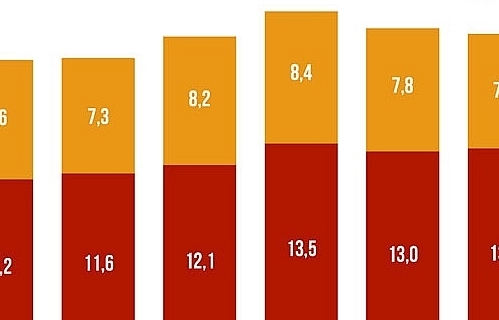Vietnamese brands in the CPTPP market still modest
| Australia is the second-largest shrimp import market of Vietnam in the CPTPP | |
| Seafood is positively exported to the CPTPP market | |
| Seafood exports to the CPTPP market are positive |
 |
| Overall scenario of the discussion |
Businesses still hesitate to build brands
At the seminar "Developing Vietnamese brands in the CPTPP market," organized by the Trade and Industry Magazine on September 27th, Ngo Chung Khanh, Deputy Head of the Multilateral Trade Policy Department (Ministry of Industry and Trade), stated that when it came to the CPTPP Agreement, it primarily focused on three markets where Vietnam did not have FTAs when the CPTPP took effect, which are Canada, Mexico, and Peru.
The other CPTPP members already had bilateral FTAs with Vietnam, such as Japan, and multilateral agreements with countries like Australia, New Zealand, Singapore, and Malaysia. Therefore, it is essential to assess how Vietnamese businesses are taking advantage of the Canadian, Mexican, and Peruvian markets.
Looking at the two markets, Canada and Mexico, since the implementation of the CPTPP, Vietnam's export growth to these two markets has consistently been in double digits. Additionally, the trade surplus that Vietnam has obtained from these two markets usually accounts for one-third to one-half of the trade surpluses with other countries. The Peruvian market offers high growth potential, with some years experiencing triple-digit growth.
Currently, many consumers in these markets are aware of certain Vietnamese brands, such as rice and coffee, but they are only familiar with specific brands within those product categories. Vietnamese brands have not yet made significant appearances on supermarket shelves or in the minds of consumers in the CPTPP countries, especially in new markets.
"However, there is still ample room for further penetration into markets like Canada, Mexico, and Peru. Some products currently represent only about 3-5% of the market share. Clearly, with large markets like Canada and even Mexico, these are figures that need consideration - how to effectively increase the percentage of Vietnamese goods in these markets," stated Khanh.
Khanh believed that businesses have still hesitated to build brands, and some were content with contract manufacturing. When asked why they did not create branded products, some businesses replied that they were involved in contract manufacturing, simply producing products as requested by importers and attaching their labels. This approach is sufficient because the importers place substantial orders, giving businesses no incentive to develop their own branded products.
Leaders of the Multilateral trade policy department argued that a lack of financial resources was also a reason that many businesses have hesitated to build their brands. Establishing a brand requires financial resources, manpower, knowledge, experience, and strategic thinking.
Building brand differentiation
Trinh Huyen Mai, Deputy Head of the Trade Promotion Department, Trade Promotion Agency (Ministry of Industry and Trade), also acknowledged that building brands and exporting under their own brand was not a story for all businesses.
This issue is only for those units that genuinely have the capacity, capability, market understanding, and a systematic strategy. This is because if an exporting business wants to ensure the quality and stability of its products while constantly capturing market trends, it must do so to maintain customers, market share, and the reputation of its brand with importers and international consumers.
According to Mai, businesses can utilize trade promotion activities to build and develop their brand. Therefore, they should actively increase the value of their products through continuous quality improvement and product diversification to suit the target market.
Businesses need to proactively learn about and actively participate in trade promotion activities organized by ministries, sectors, and associations. They should leverage the national brand, industry brand, geographical indication, and collective trademark of Vietnam when entering new markets.
In addition to investing in a systematic brand strategy and periodic communication plans, according to Mai, businesses need to pay attention to registering and protecting intellectual property rights for their branded products in foreign markets.
Sharing her experience in building a brand, Nguyen Thi Huyen, General Director of Viet Nam Staraniseed Cassia Manufacturing And Exporting JSC, said that the path to building one's brand and label was not simple at all.
"One of the directions we used was to figure out how to get our branded products on supermarket shelves. First, we need to determine what we will do and what certifications we need, not just quality standard certifications but also certifications required by supermarkets. Second, we need to work with decision-makers to get our products on those supermarket shelves. Supermarkets already have many brands, so what can we, as a newcomer brand, do to differentiate ourselves? This is called brand differentiation," shared Huyen.
Related News

Agricultural, forestry and fishery exports “reach the target” early
15:20 | 19/12/2024 Import-Export

“Give and Take” in the Value Chain of the CPTPP Market
09:30 | 20/12/2024 Import-Export

The way for Vietnamese goods in the e-commerce race
11:08 | 30/11/2024 Import-Export

Sustainable production will bring advantages to Vietnamese pepper and spices
13:44 | 06/12/2024 Import-Export
Latest News

VN faced with increasing trade defence investigations on rising protectionism
18:58 | 22/12/2024 Import-Export

Việt Nam expects to officially export passion fruit to the US next year
18:55 | 22/12/2024 Import-Export

UK’s carbon tax to affect VN exports
18:51 | 22/12/2024 Import-Export

Removing obstacles in granting certificates of exploited aquatic products
13:56 | 22/12/2024 Import-Export
More News

Promoting agricultural exports to the Japanese market
13:55 | 22/12/2024 Import-Export

Agricultural exports in 2024 to exceed 60 billion USD?
13:53 | 22/12/2024 Import-Export

Seafood exports expected to exceed $10 billion in 2025: expert
20:28 | 21/12/2024 Import-Export

Top 10 Reputable Animal Feed Companies in 2024: Efforts to survive the challenges of nature
18:30 | 21/12/2024 Import-Export

Vietnam's import-export surges 15.3%
09:44 | 20/12/2024 Import-Export

More Vietnamese firms interested in Saudi Arabia: Ambassador
09:43 | 20/12/2024 Import-Export

Binh Dinh province works to attract investment from Japan
15:44 | 19/12/2024 Import-Export

Thailand remains Vietnam’s biggest trading partner in ASEAN
15:35 | 18/12/2024 Import-Export

Rubber value soars in 2024: VRA
15:33 | 18/12/2024 Import-Export
Your care

VN faced with increasing trade defence investigations on rising protectionism
18:58 | 22/12/2024 Import-Export

Việt Nam expects to officially export passion fruit to the US next year
18:55 | 22/12/2024 Import-Export

UK’s carbon tax to affect VN exports
18:51 | 22/12/2024 Import-Export

Removing obstacles in granting certificates of exploited aquatic products
13:56 | 22/12/2024 Import-Export

Promoting agricultural exports to the Japanese market
13:55 | 22/12/2024 Import-Export





